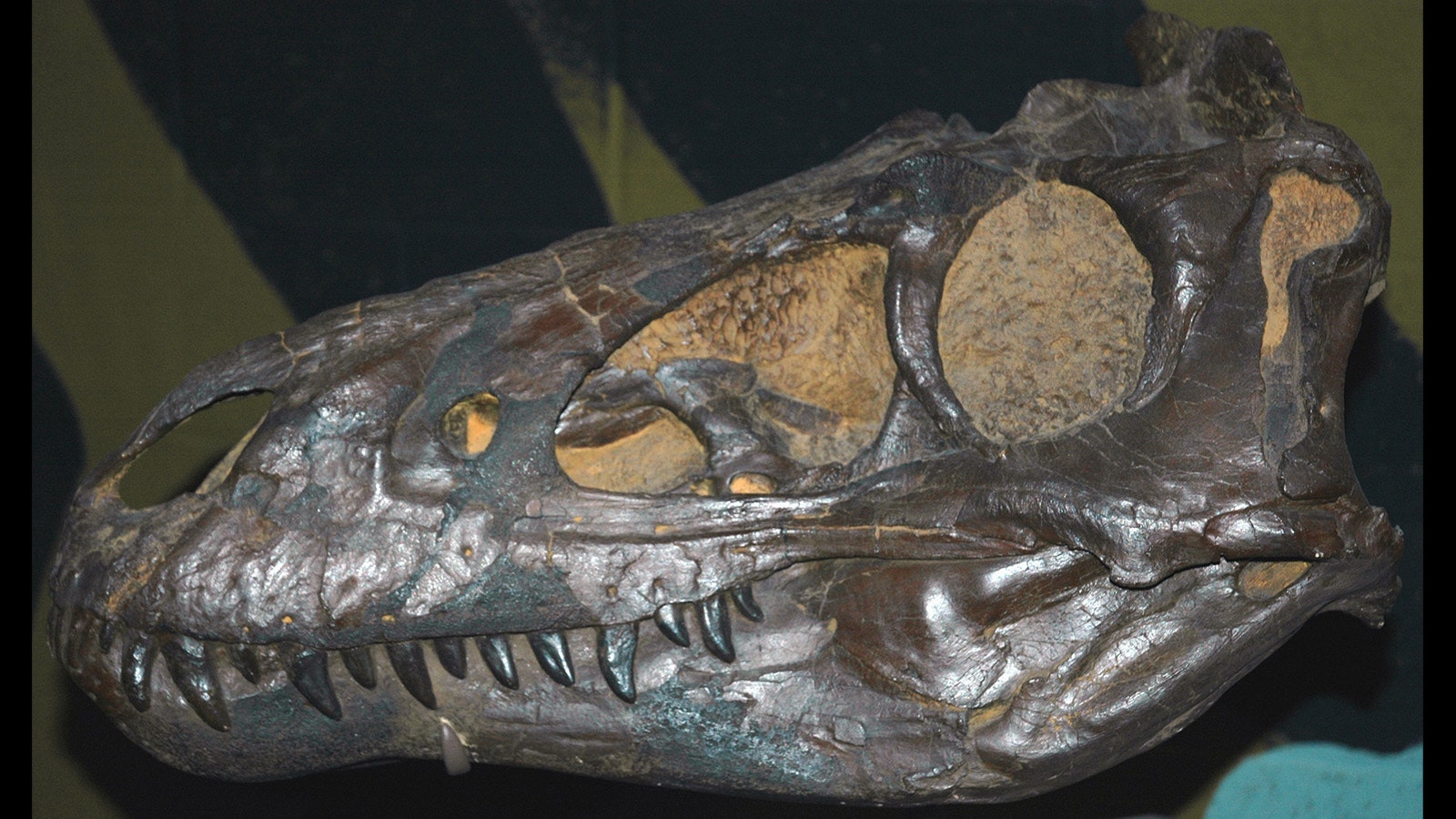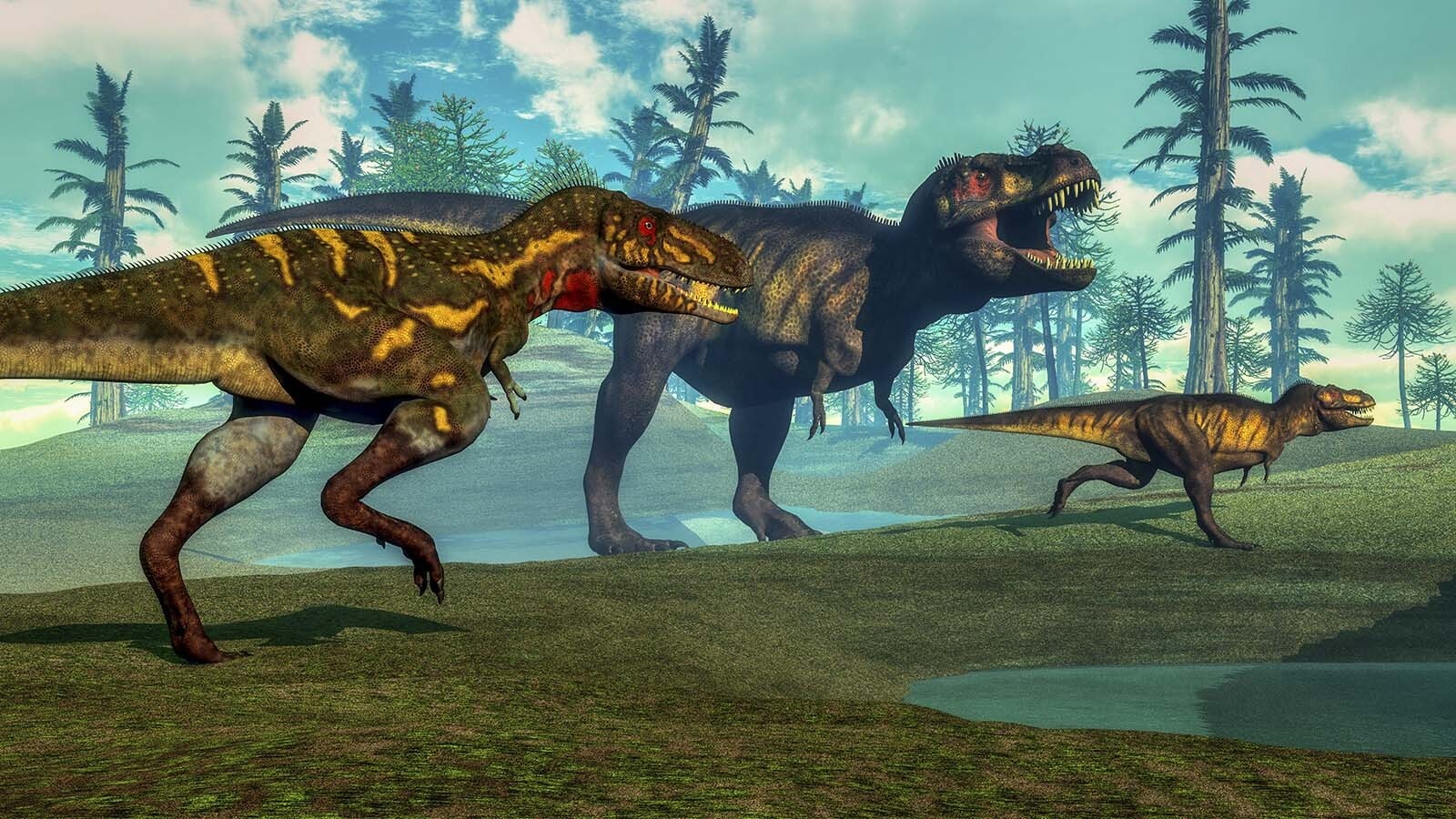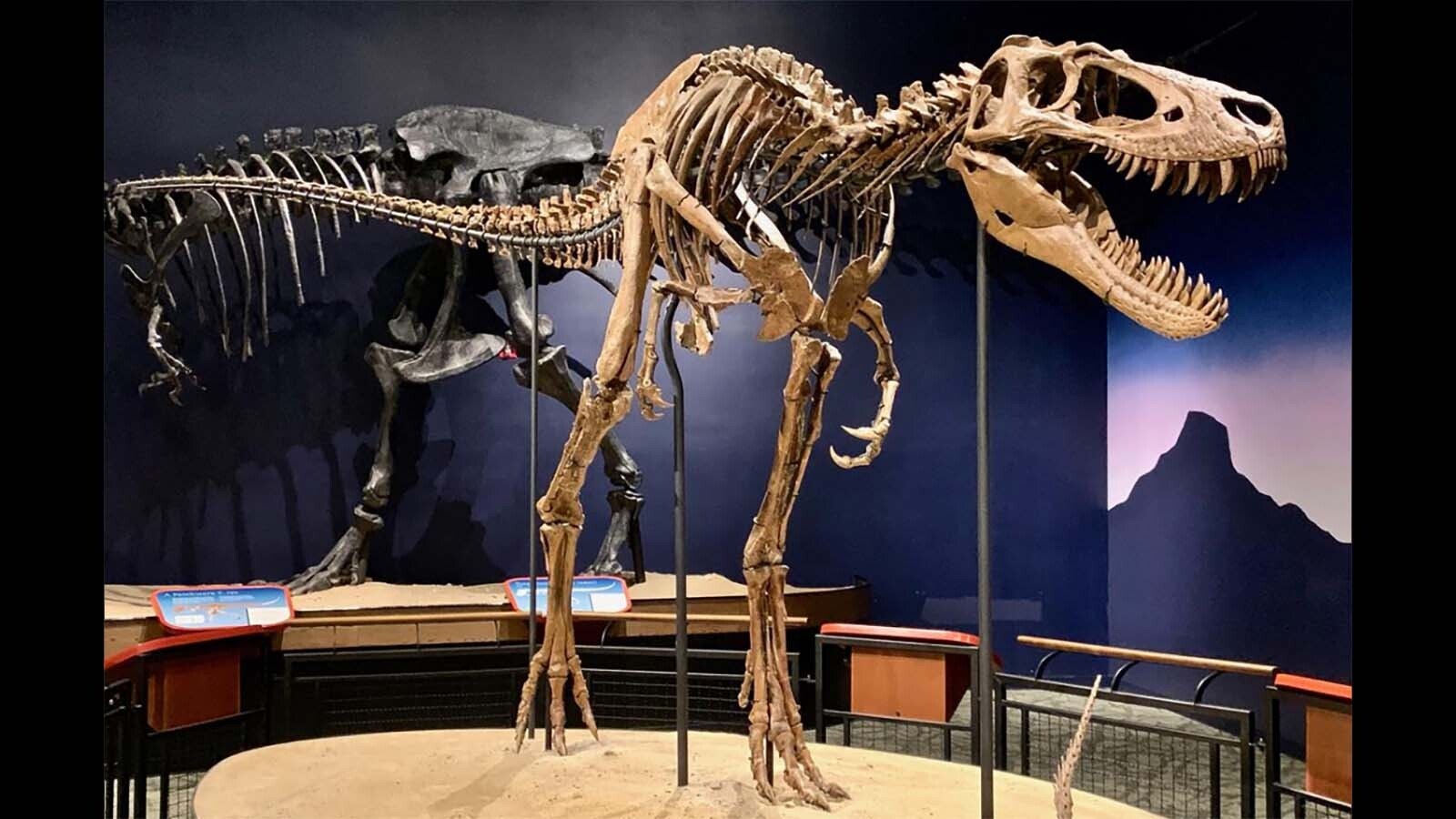The first major dinosaur news of 2024 is a tyrannical act of necromancy. New research has grabbed the paleontological equivalent of “the third rail” by making the case to resurrect Nanotyrannus, a tiny tyrant dubbed “Baby T. rex” buried in enormous controversy.
Tyrannosaurus fossils discovered in the Hell Creek Formation, which stretches across Montana and the Dakotas, have been giving paleontologists hell. A new paper published Jan. 2 is the latest fuel in the raging fire over the dinosaur diversity — or lack thereof — at the end of the Age of Dinosaurs.
“For decades, a debate has gone on as to whether certain mid-sized specimens of tyrannosaur from the Hell Creek Formation of the American West represent juveniles of Tyrannosaurus rex, or if instead, they represent a separate dinosaur called Nanotyrannus lancensis,” said Thomas Holtz, Ph.D., who is the principal lecturer on vertebrate paleontology at the University of Maryland.
The majority consensus is that there is no Nanotyrannus. Since its fossils are found in the same places as the infamous Tyrannosaurus rex, which includes Wyoming and the surrounding region, most paleontologists believe the carnivore that looks like a smaller T. rex is just a smaller T. rex.
Paleontologists Nicholas Longrich and Evan Saitta studied the interior and exterior of dozens of Tyrannosaurus fossils and those previously attributed to Nanotyrannus. Their paper concludes that “the evidence strongly supports recognition of Nanotyrannus as a distinct species.”
Nanotyrannus tends to dominate the dinosaurian discourse whenever it’s brought up, and the newest research is no exception. It’s a prehistoric standoff that’s as heated as any political debate.
Tiny Tyrant, Big Debate
The dinosaur formerly known as Nanotyrannus roamed Wyoming, Montana and the western United States about 66 million years ago at the very end of the Age of Dinosaurs. But the controversial story started in Cleveland, Ohio, in the 1980s.
The relatively complete skull of a carnivorous dinosaur was found in 1942 by the Cleveland Museum of Natural History during an excavation in the Hell Creek Formation of Montana. It was quietly kept in the museum’s basement for over 60 years.
In 1985, paleontologists Bob Bakker, Phil Currie and Michael Williams “rediscovered” the skull and described it as the distinct dinosaur species Nanotyrannus lancensis. They concluded that the legendary Tyrannosaurus was sharing its kingdom with a smaller cousin, a “pygmy tyrant,” as the name reflects.
The roar of Nanotyrannus has been deafening since.
Most paleontologists doubt the validity of Nanotyrannus for several complex reasons. The simplest (and biggest doubt) is where the divisive species resides in the fossil record and paleontology’s understanding of Tyrannosaurus.
So far, all the Nanotyrannus specimens are sub-adults, while a definitive adult has yet to be discovered. Meanwhile, those fossils are the same size and shape paleontologists would expect for a teenage Tyrannosaurus.
Validating Nanotyrannus would tear open a teenage Tyrannosaurus-sized hole many paleontologists believe Nanotyrannus already fills perfectly well.
“Definite Tyrannosaurus rex specimens of the same age-at-time-of-death as the ‘Nanotyrannus’ specimens aren't currently known,” Holtz said. “Either there are two tyrannosaurs in this community of dinosaurs, one only known from teenagers and another only known from adults, or the smaller ones are the juveniles of the adults.”

Becoming A Tyrant
Holtz is one of the world's foremost experts on Tyrannosaurus and its relatives. Once the paper burst onto social media, paleontologists and dinosaur enthusiasts worldwide eagerly awaited his take.
“Longrich and Saitta present evidence for the idea that we have two separate dinosaurs,” he told Cowboy State Daily. “This is certainly a possibility. Most of their arguments hinge on the idea that the degree of difference between the two is too much to be explained with growth.”
Holtz commended Longirch and Saitta for aspects of their thorough research. They included all the potential specimens of Nanotyrannus found since 1985, and they present a more complete list of skeletal differences between Nanotyrannus and Tyrannosaurus.
There are “accepted facts,” like the curiously slender jaws and teeth of the Nanotyrannus specimens, that raise questions on how Tyrannosaurus grew up. However, even if the fossil record of Tyrannosaurus is filled with “growing pains,” Holtz believes its close relatives offer valuable insight that explains the drastic changes all tyrannosaurs underwent.
“Animals change with growth, and animals with a lot of growing to do go through a lot of changes,” he said. “Other tyrannosaurids, like Gorgosaurus and Tarbosaurus, show many of the same differences between youngsters and adults, only not to the same extreme because the adults are not as big as adult Tyrannosaurus.”
The Teen That’s Not An Adult (And Vice Versa)
The game-changing discovery will come from a fossil that hasn’t been discovered or published yet. Holtz said that specimen would need to be “a definitive adult Nanotyrannus which is unquestionably not a Tyrannosaurus, or a 12-year-old Tyrannosaurus which is unquestionably not a Nanotyrannus.”
There are potential candidates.
“Jane,” the tyrannosaur skeleton at the Burpee Museum of Natural History in Rockford, Illinois, has been cited as the first complete specimen of Nanotyrannus.
Meanwhile, paleontologists at the North Carolina Museum of Natural Sciences are researching the “Dueling Dinosaurs,” two of the best-preserved dinosaur specimens ever found in the United States. One of the two is a 98% complete tyrannosaur in the same size range as the potential Nanotyrannus specimens.
One or both specimens might settle the controversy, but the research on them has yet to be published. Until then, since science doesn’t settle longstanding debates with “slam-dunk papers,” Holtz doesn’t think the new paper conclusively ends the Nanotyrannus debate.
“Some might find this paper convincing, and that is perfectly reasonable,” he said. “But others may still hold off on this hypothesis for the time being.”
Siamese Or Orange Tabby?
Angela Reddick is a paleontologist who works with Northwest College in Powell and the Washakie Museum in Worland. She has a master's degree in Geology from Northern Illinois University and a background in mathematics and statistics.
Reddick isn’t a tyrannosaur expert, but her master’s thesis was on a statistical analysis that grouped the femora, upper leg bones, of multiple individual Allosaurus, the large Late Jurassic carnivore, by age of the individual the femur belonged to.
From a statistical perspective, Reddick thinks a compelling case has been presented.
“I think it makes a lot of sense,” she said. “It's a little hard to say, but I agree with their general conclusions. Nanotyrannus, in my opinion, probably is a separate species.”
However, the lines between different species and different individuals can be tricky. Longrich and Saitta’s study used a variety of skeletal differences, mainly in the skulls of Tyrannosaurus, to show several distinct traits not seen in Tyrannosaurus but present in all the Nanotyrannus specimens.
Reddick described the dilemma of classifying dinosaur species by comparing it to the outlandish variety in today’s furry companions.
“It’s difficult to differentiate species when they’re closely related,” she said. “When looking at the Siamese cat versus an orange tabby cat, they're not different species. Whereas when you have two dog breeds, like a Great Dane and a Chihuahua, those are ridiculously different but can interbreed and produce viable offspring. You can’t always tell when they're that closely related.”
Reddick also wishes the paper looked beyond the dinosaurs’ skulls and deeper at the other parts of their skeletons. A head can tell someone a lot, but it’s not the whole story.
“There is a distinct difference in length, girth and shape in some leg bones that I would say still are consistent among one species, let alone might be indicative of (multiple species.)”

Breaking The Lance In Wyoming
Nearly all the hotly debated fossils of Nanotyrannus, including the Cleveland specimen, “Jane” and the Dueling Dinosaurs, have come from Montana, a paradise for anyone hunting Tyrannosaurus and its tyrannical kin.
In Wyoming, several Tyrannosaurus fossils and a handful of complete skeletons have been found, but nearly all have come from adults. Wyoming is seen as a lesser vassal state in the realm of the Tyrant Lizard King and barely factors into the Nanotyrannus debate.
However, a growing amount of fossil evidence is being collected from the Late Cretaceous rocks of Wyoming. The battle raging over the owner of dinosaur bones in Montana may be solved by the teeth and other fossils emerging outside Glenrock.
The Triceratops Gulch Project has collected thousands of fossils from the Lance Formation, which was deposited when Tyrannosaurus ruled Wyoming. For several summers, dozens of paleontologists and citizen scientists have traveled to Glenrock to assist in the excavation.
Matt Mossbrucker, director of the Morrison Museum of Natural History in Morrison, Colorado, has led the project with the Glenrock Paleon Museum. Fossils excavated and examined by Mossbrucker and his field teams in Glenrock have informed his professional opinion on the validity of Nanotyrannus.
“I remain unconvinced that Nanotyrannus is a juvenile Tyrannosaurus,” he said. “As someone who approaches these contestable fossils without the zeal for the mythos behind tyrannosaurs, I think the growing sample of Nanotyrannus fossils indicates it was a distinctive animal. Frankly, if it weren't found in the same beds that entombed Tyrannosaurus, I do not think we would be having this discussion.”
The Hell Creek Formation in Montana and South Dakota ranks as one of the most studied rock layers in the world. The lesser-known but contemporaneous Lance Formation in Wyoming reveals another view of the prehistoric past, and the answer to the vexing Nanotyrannus question may be in that view.
Wyoming fossils may have played a small part in the ongoing controversy, but Mossbrucker believes they will have a significant role in the future of Nanotyrannus.
“Bones and teeth collected by the crew at Triceratops Gulch, along with the specimens I have examined, have given me insight into this dinosaur,” he said. “Nanotyrannus seems to be a more common large carnivore during the end-Cretaceous than T. rex in our field area in the Lance Formation outside Glenrock. Wyoming's fossils will no doubt play a key role in understanding Nanotyrannus.”
Mossbrucker and his colleagues are working on their own research based on the fossils collected from Triceratops Gulch. Once published, it will add more knowledge to the paleontological community and fodder for the ongoing debate over Nanotyrannus.
Ultimately, the dinosaurs themselves will answer these long-standing questions once their fossils emerge from millions of years of burial and reveal their secrets. Mossbrucker cited the words of John Bell Hatcher, the legendary paleontologist who found the first fossils of Wyoming’s state dinosaur (and Tyrannosaurus/Nanotyrannus dinner option), Triceratops.
“The fossils contradict expert opinions,” he said. “Understanding dinosaurs is a numbers game. The more fossils collected, with contextual data, the greater our perception of these animals. Each summer field season yields new finds, and summertime is around the corner.”
Andrew Rossi can be reached at arossi@cowboystatedaily.com.





